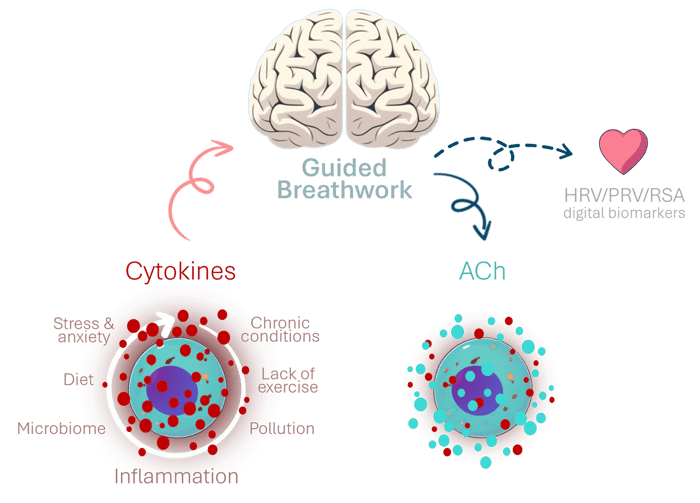Table of Contents
The vagus nerve is a crucial part of the parasympathetic nervous system, playing a significant role in regulating stress and promoting relaxation. One effective way to stimulate this nerve is through slow-paced breathing, particularly at a frequency of 0.1 Hz, (about six breaths per minute) with controlled, longer exhalation. This technique can enhance physical and mental well-being by optimizing the body's response to stress and improving overall health.
The Science of Slow-Paced Breathing
What Is 0.1 Hz Breathing?
Slow-paced breathing at 0.1 Hz involves taking six breaths per minute, each full breath cycle lasting ten seconds. Properly practiced, with shorter inhalation and longer exhalation, this rhythm promotes relaxation and reduces stress. Studies show that prolonged expiratory breathing (6 seconds expiration, 4 seconds inspiration) yields significant results.
Physiological Effects
- Heart Rate Variability (HRV): Slow-paced breathing increases HRV, a measure of the variation in time between heartbeats. Higher HRV is linked to a stronger vagal tone and improved stress management. Vagal tone refers to the activity of the vagus nerve. A higher vagal tone is commonly associated with a relaxed state, improved emotional regulation, and better stress resilience. Moreover, recent science demonstrates that HRV can be used to assess inflammation.
- Blood Pressure Regulation: This breathing technique helps regulate blood pressure by promoting vasodilation and reducing the workload on the heart.
- Enhanced Oxygenation: Deep, slow breaths improve oxygen exchange, enhancing energy levels and cognitive function.
The Mechanism of 0.1 Hz Breathing
Heart Rate Variability (HRV)
0.1 Hz breathing optimizes heart rate variability (HRV), which is a key indicator of overall health and well-being.
Noninvasively measured, HRV yields a very comprehensive understanding of your brain and body's activity, including for example your response to alcoholic drinks since two alcoholic drinks can decrease total HRV by 28–33%, therefore reducing your ability to regulate inflammation.
- Resonance Frequency: Breathing at 0.1 Hz aligns with the body's natural rhythms, maximizing HRV for enhanced physiological and mental health, both in the moment or in the long run.
Baroreflex Sensitivity
The baroreflex is a crucial mechanism that maintains blood pressure stability. Slow breathing increases the sensitivity of this reflex, helping to regulate blood pressure effectively.
- Blood Pressure Modulation: Enhanced baroreflex function through slow-paced breathing leads to vasodilation, lowering blood pressure and reducing cardiovascular strain.
Neurotransmitter Dynamics
Breathing at 0.1 Hz frequency boosts the release of key neurotransmitters, notably acetylcholine, which promotes relaxation, reduces stress and supports anti-inflammatory regulation.
- Acetylcholine (ACh): This neurotransmitter activates the vagus nerve, enhancing parasympathetic activity. It supports immune function and helps restore calm.

Scientific Studies and Insights
Clinical Research
Numerous studies highlight the benefits of slow-paced breathing on HRV and vagal tone.
- Anxiety and Depression: Research demonstrates that slow breathing can significantly alleviate symptoms by modulating the autonomic nervous system, promoting a sense of calm and balance.
- Inflammation Reflex and Chronic Pain Management: Slow-paced breathing is effective in managing chronic pain by activating the body’s natural pain-relief pathways and reducing inflammation.
Practical Applications
- Therapeutic Use: Therapists incorporate slow breathing techniques in treatments such as cognitive behavioral therapy and biofeedback, enhancing therapeutic outcomes.
- Athletic Performance: Athletes use 0.1 Hz breathing to improve recovery times and performance by optimizing cardiovascular efficiency and mental focus.
Alternative Vagal Tone Stimulation
- Electrical: Electrical vagus nerve stimulation (eVNS) is a non-pharmacological technique that uses electrical impulses to stimulate the vagus nerve. Vagus nerve stimulators can be implanted, requiring surgery and with potentially serious side effects. In recent years, noninvasive vagus nerve stimulation devices that don't require surgery have been developed. When compared, deep breathing and electrical vagus nerve stimulation are shown to both increase HRV (vagal tone parameters), although with superior results with breathing-based stimulation.
Integration into Daily Life
In addition to inflammation regulation, incorporating 0.1 Hz breathing into daily routines can transform stress responses and improve overall health.
- Work Stress Management: Use slow breathing during work breaks to enhance concentration and manage stress effectively.
- Sleep Enhancement: Practicing this technique before bedtime promotes relaxation, making it easier to fall asleep and achieve restful sleep.
By understanding and applying the science of 0.1 Hz breathing, you can tap into its powerful effects to improve both physical and mental health. This simple, science-backed practice offers a natural and accessible way to enhance resilience to stress and promote a balanced state of well-being.
Benefits of Stimulating the Vagus Nerve
Strengthened Immune Response
A well-functioning vagus nerve helps regulate the immune system, reducing inflammation and enhancing the body's ability to fight infections.
Stress Reduction
Activating the vagus nerve through slow-paced breathing reduces cortisol levels, the primary stress hormone. This leads to a calmer state, decreased anxiety, and improved mood.
Improved Mental Health
By enhancing vagal tone, slow-paced breathing can help manage symptoms of depression and anxiety. It promotes a sense of well-being and emotional stability.
Enhanced Digestion
Stimulating the vagus nerve supports digestive health by increasing gastric motility and enzyme secretion, helping to prevent issues like bloating and indigestion.
The benefits of vagus nerve stimulation are numerous, both supportive and essential to overall health. With Seesaw Health, daily stimulation and accurate measurement of vagal activity is easy to put into action.
The Science Behind Vagal Stimulation
Research Insights
Studies show that slow-paced breathing can significantly increase vagal tone and HRV, leading to better stress management and emotional regulation. This technique is used in therapies like biofeedback and cognitive behavioral therapy to treat anxiety and depression.
Neurotransmitter Release
Vagal stimulation increases the release of neurotransmitters such as acetylcholine and gamma-aminobutyric acid (GABA), which play roles in calming the nervous system and enhancing mood.
Reduce inflammation
Slow-paced breathing at 0.1 Hz reduces inflammation by enhancing vagal tone, which activates the cholinergic anti-inflammatory pathway. This process involves the release of acetylcholine, a neurotransmitter that interacts with immune cells to suppress the production of pro-inflammatory cytokines. By decreasing these cytokines, slow-paced breathing helps lower overall inflammation levels in the body. Additionally, increased heart rate variability (HRV) from this practice reflects improved autonomic balance, further contributing to the regulation of inflammatory responses and supporting overall immune health.
Applying Slow-Paced Breathing in Daily Life for Inflammation Management
Morning Routine
Start your day with a brief session of slow-paced breathing to set a calm tone. This practice can help regulate inflammation and prepare your body for the day ahead by reducing stress-induced inflammatory responses.
Work Breaks
Incorporate 0.1 Hz breathing during work breaks to counteract stress and minimize its inflammatory effects. Taking a few minutes to breathe deeply can enhance focus and decrease stress-related inflammation.
Exercise Recovery
After workouts, practice slow-paced breathing to aid recovery by reducing exercise-induced inflammation. This can help muscles recover faster and improve overall fitness.
Evening Wind-Down
Use slow breathing before bed to promote relaxation and reduce nighttime inflammation. This practice can improve sleep quality, which is crucial for maintaining healthy inflammation levels.
Stressful Situations
Whenever you face a stressful situation, engage in slow-paced breathing to manage immediate stress and prevent its inflammatory impact. This proactive approach can keep inflammation in check and support long-term health.
By integrating slow-paced breathing into various aspects of daily life, you can effectively manage inflammation and promote overall well-being.
Stimulating the vagus nerve through 0.1 Hz slow-paced breathing is a powerful tool for enhancing physical and mental health. By integrating this simple yet effective practice into your daily routine, you can improve inflammation regulation, stress resilience, emotional well-being, and overall quality of life. With regular practice, you’ll unlock the numerous benefits of a well-functioning vagus nerve.
Ready to experience the transformative power of 0.1 Hz breathwork?Discover
Disclaimer: This blog post is intended for informational purposes only and should not be considered medical advice. Always consult with a qualified healthcare professional for any health concerns or before making any decisions related to your health or treatment.
References
Adhana, R., et al. (2013). Effect of slow and fast pranayama on perceived stress and cardiovascular parameters in young healthy volunteers. Journal of Clinical and Diagnostic Research, 7(6), 1034-1038.
Bhattacharya, A., et al. (2019). Effect of slow breathing exercise on autonomic functions, pulmonary function and perceived stress in healthy volunteers. Indian Journal of Physiology and Pharmacology, 63(3), 298-305.
Bonaz, B., et al. (2017). Vagus nerve stimulation: From epilepsy to the cholinergic anti-inflammatory pathway. Neurogastroenterology & Motility, 29(10), e13118.
Gerritsen, L., & Rijken, H. (2016). Effects of yoga on vagal tone and heart rate variability. International Journal of Yoga, 9(1), 13-20.
Hofmann, S. G., et al. (2010). The effect of deep breathing on anxiety. Depression and Anxiety, 27(2), 187-194.
Jaroszewski, A., et al. (2021). Breathing exercises in the treatment of patients with post-COVID-19 syndrome: A randomized controlled pilot study. Frontiers in Physiology, 12, 646718.
Kolacz, J., Lewis, G., & Porges, S. W. (2019). The relationship between vagal tone and psychiatric conditions: A systematic review and meta-analysis. Psychiatry Research, 275, 304-316.
Lehrer, P. M., et al. (2000). Heart rate variability biofeedback: How and why does it work? Frontiers in Psychology, 1, 227.
McEwen, B. S. (2000). The neurobiology of stress: From serendipity to clinical relevance. Brain Research, 886(1-2), 172-189.
Noble, D. J., & Hochman, S. (2019). Hypothesis: Pulmonary afferent activity patterns during slow, deep breathing contribute to the neural induction of physiological relaxation. Frontiers in Physiology, 10, 1176.
FAQs
What is the vagus nerve and why is it important?
The vagus nerve is a key component of the parasympathetic nervous system, running from the brain through the chest and abdomen. It regulates heart rate, digestion, inflammation, and stress response. Stimulating it can promote calm, resilience, and overall nervous system balance.
How does 0.1 Hz breathwork stimulate the vagus nerve?
0.1 Hz breathwork, or resonant breathing at ~6 breaths per minute, increases vagal tone by sending calming signals to the brain and body. Each slow exhale activates the vagus nerve, promoting parasympathetic dominance, lowering stress hormones, and improving heart rate variability (HRV).
What are the benefits of stimulating the vagus nerve with breathwork?
Vagal activation through breathwork can:
Reduce stress and anxiety
Improve emotional regulation
Lower inflammation
Support hormonal balance
Enhance sleep and recovery
Increase resilience to everyday stressor
How do I practice 0.1 Hz breathwork correctly?
Start with 5–10 minutes of slow, rhythmic breathing. Inhale smoothly, then exhale slightly longer than your inhale. Aim for one full breath cycle every 10 seconds (~6 breaths per minute). Consistency over time strengthens vagal tone and parasympathetic activity.
How can I track if my vagus nerve is activated?
Heart rate variability (HRV) is a key indicator of vagal activity. Devices like Seesaw Health’s Egg biosensor provide real-time feedback, showing how breathwork affects your nervous system, helping you optimize sessions and monitor stress recovery.




